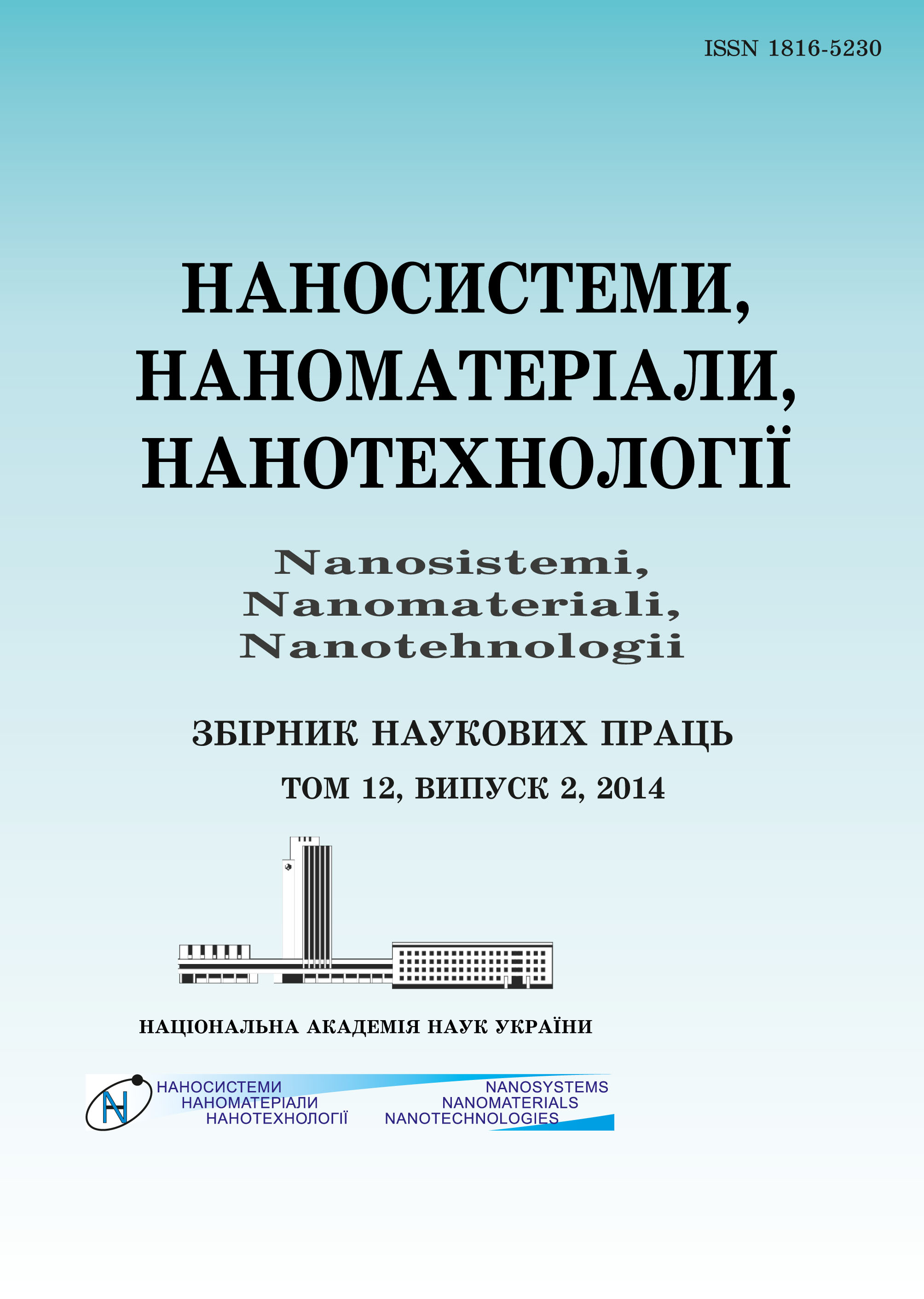|
|
|||||||||
 |
Year 2017, Volume 15, Issue 2 |
|
|||||||
|
|||||||||
Âûïóñêè/2017/òîì 15 /âûïóñê 2 |
O. M. Lisova, S. M. Makhno, G. M. Gunya, Yu. I. Sementsov, M. T. Kartel’
«Electrophysical Properties of the Polyamide–Graphene Nanoplates’ System»
289–298 (2017)
PACS numbers: 72.80.Tm, 73.63.Bd, 77.22.Ch, 81.05.Qk, 81.07.-b, 81.70.Pg, 82.35.Np
Graphene nanoplates (GN) are popular to research as their base or using them created many prototypes of a variety of electronic and optoelectronic devices, namely, LCD and solar cells, photodetectors, FETs, diodes, gas and biosensors of high sensitivity, capacitors of large capacity and so on. The properties of composites based on polyamide 1212 containing GN to 0.06 of volume fraction are studied. The GN are obtained by electrochemical dispersion of graphite electrodes in an alkaline electrolyte (KOH) of low concentration by passing a current of 6.0 to 60 mA/cm2. For separation of large graphite particles, nanoscale electrodes are placed between polypropylene filter fabric. Particle sizes are from 33 to 800 nm (most possible size is 41.6 nm). Particles form a stable suspension. Composites are obtained as follows: polyamide powder to industrial brand GN 1212 is added to the suspension, dispersed in ultrasonic disperser for 2 minutes, and dried at temperature of 350 K. The samples are pressed from polymer melt at temperature of 460 K and pressure of 5 MPa. DTA method shows that increasing content GN leads to a shift of the melting point of the polymer to low temperatures and to increased degradation of the polymer. Electrical conductivity at low frequencies are measured by two-contact method; the study of the real (??) and imaginary (??) components of the complex permittivity of composites is held in a microwave range 8–12 GHz using electrodeless interferometer method. The concentration dependence of conductivity at low frequencies and the real and imaginary components of complex permittivity of composites at a frequency of 9 GHz are changing nonlinearly in the concentration range 0.005–0.03 that indicates the presence of percolation threshold, when the GN content is of 0.011. For the system designed, the critical percolation-theory index is estimated as t = 2.38, and the efficient array GN conductivity is ?i = 1.36·101 Ohm?1?cm?1. The method of impedance spectroscopy shows that the output GN conductance is due to electron component mainly.
Key words: graphene nanoplates, dielectric constant, composites, electrical conductivity.
https://doi.org/10.15407/nnn.15.02.0289
REFERENCES
1. Z. Y. Sui and B. H. Han, Carbon, 82: 590 (2015).
https://doi.org/10.1016/j.carbon.2014.11.014
2. P. B. Sorokin and L. A. Chernozatonsky, Uspekhi Fisicheskikh Nauk, 183: 2 (2013) (in Russian).
https://doi.org/10.3367/UFNr.0183.201302a.0113
3. Y. Sun, Q. Wu, and G Shi, Energy Environ. Sci., 4: 4 (2011).
https://doi.org/10.1039/c0ee00683a
4. Y. V. Stebunov, O. A. Afteneva, A. V. Arsenin, and V. S. Volkov, ACS Applied Materials & Interfaces, 7, No. 39: 21 (2015). doi: 10.1021/acsami.5b04427.
https://doi.org/10.1021/acsami.5b04427
5. Z. Cai, X. Meng, Y. Han, H. Ye, L. Cui, and Q. Zhou, Composites: Part A, 69: 115 (2015).
https://doi.org/10.1016/j.compositesa.2014.11.011
6. S. M. Makhno, O. M. Lisova, G. M. Gunya, Yu. I. Sementsov, Yu. V. Grebelna, and M. T. Kartel', Physics and Chemistry of Solid State, 17: 3 (2016) (in Ukrainian).
https://doi.org/10.15330/pcss.17.3.421-425
7. L. M. Ganyuk, V. D. Ignatkov, S. M. Makhno, and P. M. Soroka, Ukrainsky Fizychny Zhurnal, 40: 6 (1995) (in Ukrainian).
8. M. Kartel, Yu. Sementsov, S. Mahno, V. Trachevskiy, and Wang Bo, Universal Journal of Materials Science, 4, No. 2: 23 (2016). DOI: 10.13189/ujms.2016.040202.
https://doi.org/10.13189/ujms.2016.040202
9. C. Botas, A. Lvarez, P. Blanco, M. Granda, C. Blanco, R. Santamaria, L. J. Romasanta, R. Verdejo, and M. A. Lopez-Manchado, and R. Menendez, Carbon, 65: 156 (2013).
https://doi.org/10.1016/j.carbon.2013.08.009
10. V. G. Shevchenko and A. T. Ponomarenko, Uspekhi Khimii, LII: 8 (1983) (in Russian).
11. G. C. Psarras, E. C. Manolakaki, and G. M. Tsangaris, Composites: Part A, 33, No. 3: 375 (2002).
https://doi.org/10.1016/S1359-835X(01)00117-8
|
©2003—2021 NANOSISTEMI, NANOMATERIALI, NANOTEHNOLOGII G. V. Kurdyumov Institute for Metal Physics of the National Academy of Sciences of Ukraine.
E-mail: tatar@imp.kiev.ua Phones and address of the editorial office About the collection User agreement |